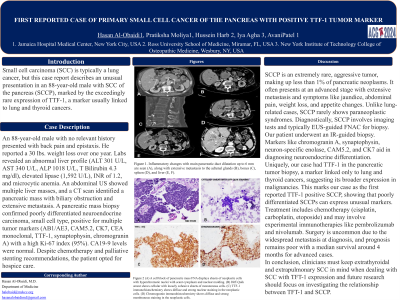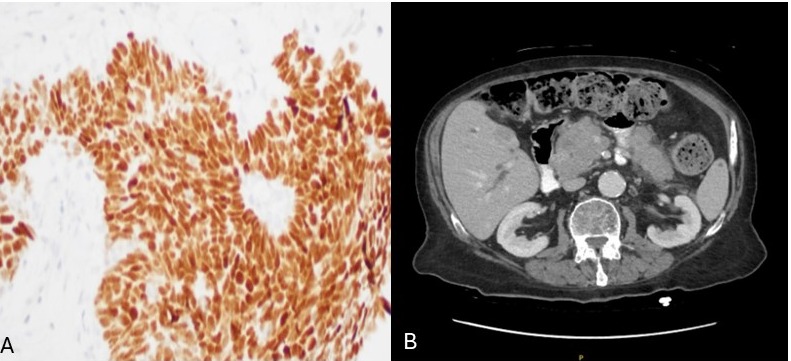Tuesday Poster Session
Category: Biliary/Pancreas
P3565 - First Reported Case of Primary Small Cell Cancer of the Pancreas With Positive TTF-1 Tumor Marker
Tuesday, October 29, 2024
10:30 AM - 4:00 PM ET
Location: Exhibit Hall E

Has Audio

Hasan Al-Obaidi, MD
Jamaica Hospital Medical Center
Briarwood, NY
Presenting Author(s)
Hasan Al-Obaidi, MD1, Pratiksha Moliya, MD2, Hussein Harb, MS3, Iya Agha, MS4, Avani Patel, MD5
1Jamaica Hospital Medical Center, Briarwood, NY; 2Jamaica Hospital Medical Center, Edison, NJ; 3Ross University School of Medicine, Miramar, FL; 4New York Institute of Technology College of Osteopathic Medicine, New York, NY; 5Jamaica Hospital Medical Center, Queens, NY
Introduction: Small cell carcinoma (SCC) is typically a lung cancer, but this case report describes an unusual presentation in an 88-year-old male with SCC of the pancreas (SCCP), marked by the exceedingly rare expression of TTF-1, a marker usually linked to lung and thyroid cancers.
Case Description/Methods: An 88-year-old male with no relevant history presented with back pain and epistaxis. He reported a 30 lbs. weight loss over one year. Labs revealed an abnormal liver profile (ALT 301 U/L, AST 340 U/L, ALP 1018 U/L, T Bilirubin 4.3 mg/dl), elevated lipase (1,592 U/L), INR of 1.2, and microcytic anemia. An abdominal US showed multiple liver masses, and a CT scan identified a pancreatic mass with biliary obstruction and extensive metastasis. A pancreatic mass biopsy confirmed poorly differentiated neuroendocrine carcinoma, small cell type, positive for multiple tumor markers (AB1/AE3, CAM5.2, CK7, CEA monoclonal, TTF-1, synaptophysin, chromogranin A) with a high Ki-67 index (95%). CA19-9 levels were normal. Despite chemotherapy and palliative stenting recommendations, the patient opted for hospice care.
Discussion: SCCP is an extremely rare, aggressive tumor, making up less than 1% of pancreatic neoplasms. It often presents at an advanced stage with extensive metastasis and symptoms like jaundice, abdominal pain, weight loss, and appetite changes. Unlike lung-related cases, SCCP rarely shows paraneoplastic syndromes. Diagnostically, SCCP involves imaging tests and typically EUS-guided FNAC for biopsy. Our patient underwent an IR-guided biopsy. Markers like chromogranin A, synaptophysin, neuron-specific enolase, CAM5.2, and CK7 aid in diagnosing neuroendocrine differentiation. Uniquely, our case had TTF-1 in the pancreatic tumor biopsy, a marker linked only to lung and thyroid cancers, suggesting its broader expression in malignancies. This marks our case as the first reported TTF-1 positive SCCP, showing that poorly differentiated SCCPs can express unusual markers. Treatment includes chemotherapy (cisplatin, carboplatin, etoposide) and may involve experimental immunotherapies like pembrolizumab and nivolumab. Surgery is uncommon due to the widespread metastasis at diagnosis, and prognosis remains poor with a median survival around 4 months for advanced cases.
In conclusion, clinicians must keep extrathyroidal and extrapulmonary SCC in mind when dealing with SCC with TFT-1 expression and future research should focus on investigating the relationship between TFT-1 and SCCP.

Disclosures:
Hasan Al-Obaidi, MD1, Pratiksha Moliya, MD2, Hussein Harb, MS3, Iya Agha, MS4, Avani Patel, MD5. P3565 - First Reported Case of Primary Small Cell Cancer of the Pancreas With Positive TTF-1 Tumor Marker, ACG 2024 Annual Scientific Meeting Abstracts. Philadelphia, PA: American College of Gastroenterology.
1Jamaica Hospital Medical Center, Briarwood, NY; 2Jamaica Hospital Medical Center, Edison, NJ; 3Ross University School of Medicine, Miramar, FL; 4New York Institute of Technology College of Osteopathic Medicine, New York, NY; 5Jamaica Hospital Medical Center, Queens, NY
Introduction: Small cell carcinoma (SCC) is typically a lung cancer, but this case report describes an unusual presentation in an 88-year-old male with SCC of the pancreas (SCCP), marked by the exceedingly rare expression of TTF-1, a marker usually linked to lung and thyroid cancers.
Case Description/Methods: An 88-year-old male with no relevant history presented with back pain and epistaxis. He reported a 30 lbs. weight loss over one year. Labs revealed an abnormal liver profile (ALT 301 U/L, AST 340 U/L, ALP 1018 U/L, T Bilirubin 4.3 mg/dl), elevated lipase (1,592 U/L), INR of 1.2, and microcytic anemia. An abdominal US showed multiple liver masses, and a CT scan identified a pancreatic mass with biliary obstruction and extensive metastasis. A pancreatic mass biopsy confirmed poorly differentiated neuroendocrine carcinoma, small cell type, positive for multiple tumor markers (AB1/AE3, CAM5.2, CK7, CEA monoclonal, TTF-1, synaptophysin, chromogranin A) with a high Ki-67 index (95%). CA19-9 levels were normal. Despite chemotherapy and palliative stenting recommendations, the patient opted for hospice care.
Discussion: SCCP is an extremely rare, aggressive tumor, making up less than 1% of pancreatic neoplasms. It often presents at an advanced stage with extensive metastasis and symptoms like jaundice, abdominal pain, weight loss, and appetite changes. Unlike lung-related cases, SCCP rarely shows paraneoplastic syndromes. Diagnostically, SCCP involves imaging tests and typically EUS-guided FNAC for biopsy. Our patient underwent an IR-guided biopsy. Markers like chromogranin A, synaptophysin, neuron-specific enolase, CAM5.2, and CK7 aid in diagnosing neuroendocrine differentiation. Uniquely, our case had TTF-1 in the pancreatic tumor biopsy, a marker linked only to lung and thyroid cancers, suggesting its broader expression in malignancies. This marks our case as the first reported TTF-1 positive SCCP, showing that poorly differentiated SCCPs can express unusual markers. Treatment includes chemotherapy (cisplatin, carboplatin, etoposide) and may involve experimental immunotherapies like pembrolizumab and nivolumab. Surgery is uncommon due to the widespread metastasis at diagnosis, and prognosis remains poor with a median survival around 4 months for advanced cases.
In conclusion, clinicians must keep extrathyroidal and extrapulmonary SCC in mind when dealing with SCC with TFT-1 expression and future research should focus on investigating the relationship between TFT-1 and SCCP.

Figure: Figure A: Histological image from tumor biopsy shows positive TTF-1 immunohistochemistry.
Figure B: CTAP reveals a pancreatic head mass approximately 5.4 × 5.4 cm, indicative of pancreatic cancer.
Figure B: CTAP reveals a pancreatic head mass approximately 5.4 × 5.4 cm, indicative of pancreatic cancer.
Disclosures:
Hasan Al-Obaidi indicated no relevant financial relationships.
Pratiksha Moliya indicated no relevant financial relationships.
Hussein Harb indicated no relevant financial relationships.
Iya Agha indicated no relevant financial relationships.
Avani Patel indicated no relevant financial relationships.
Hasan Al-Obaidi, MD1, Pratiksha Moliya, MD2, Hussein Harb, MS3, Iya Agha, MS4, Avani Patel, MD5. P3565 - First Reported Case of Primary Small Cell Cancer of the Pancreas With Positive TTF-1 Tumor Marker, ACG 2024 Annual Scientific Meeting Abstracts. Philadelphia, PA: American College of Gastroenterology.
